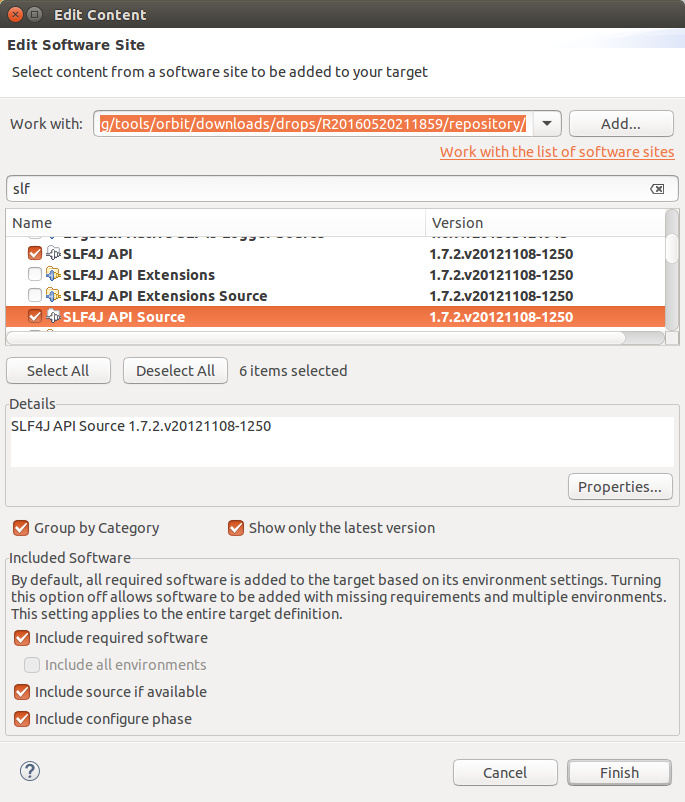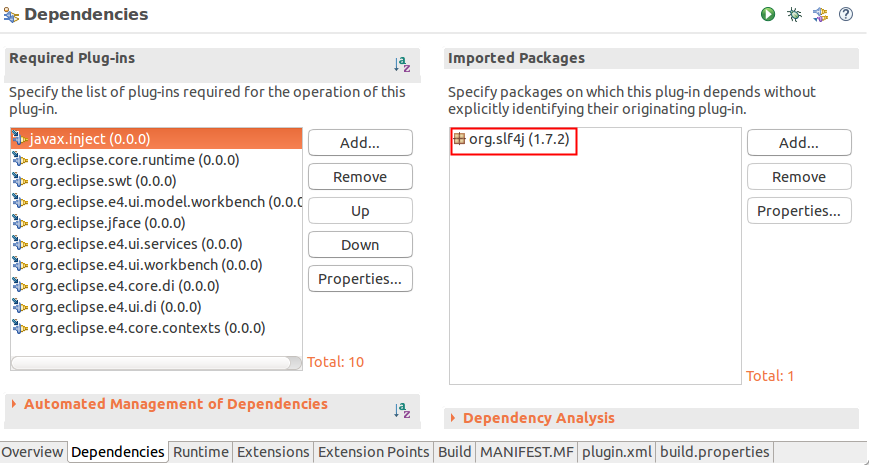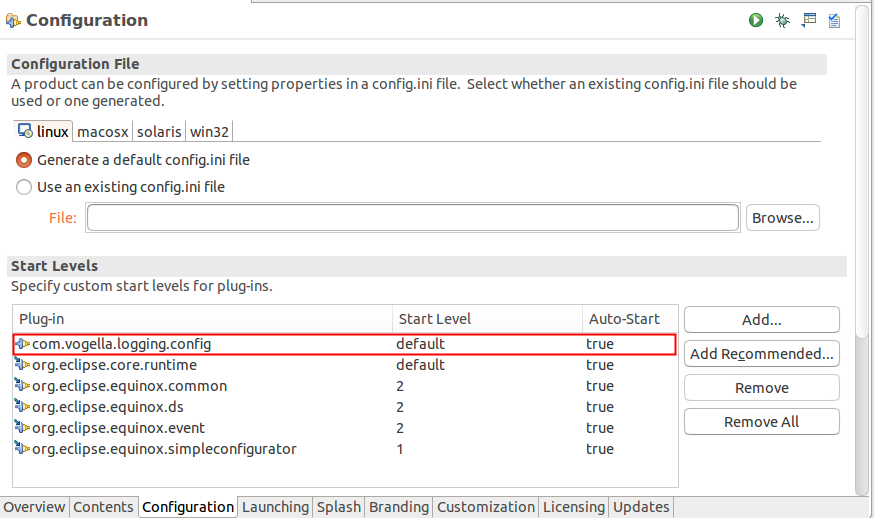Lars Vogel (c) 2009 - 2025 vogella GmbH :revnumber: 1.7 :revdate: 30.09.2025
Using Eclipse logging. This tutorial gives an overview how to do logging in an Eclipse application.
1. Eclipse Logging
The Eclipse ILog class provides a simple set of APIs for logging exceptions, warnings, or other information useful in debugging or servicing a deployed Eclipse product.
The intent of the log is to record information that can be used later to diagnose problems in the field.
Because this information is not directed at users, you do not need to worry about translating messages or simplifying explanations into a form that users will understand.
The idea is that when things go wrong in the field, your users can send you the log file to help you figure out what happened.
Each plug-in has its own log associated with it, but all logged information eventually makes its way into the platform log file (see the getLogFileLocation method on Platform).
import org.eclipse.core.runtime.ILog;
ILog.get().info("Starting");
ILog.get().error("Generating template failed!", e);
ILog.get().warn("Creating a warning..");
During development, you can browse and manipulate the platform log file using the Error Log view (Window > Show View > General > Error Log).
You can have the log file mirrored in the Java console by starting Eclipse with the -consoleLog command-line argument.
More complex logging is available through the org.eclipse.core.runtime.ILog interface.
You can write IStatus objects to the log file, including a MultiStatus.
MultiStatus is used if you have hierarchies of information to display.
If you create your own subclass of the utility class Status, you can override the getMessage method to return extra information to be displayed in the log file.
The log level can be configured in the config.ini file of your application using the eclipse.log.level parameter. The value can be set to INFO, WARNING and ERROR. INFO will, for example, show all log messages. By default, Eclipse logs all messages.
2. SLF4J in Eclipse applications
Many Java developers are more familiar with the SLF4J logging facade, which is more powerful than Eclipse’s default logger.
2.1. Obtaining the SLF4J library from Orbit
The Eclipse Orbit Project provides many different open-source libraries that can be obtained as OSGi bundles from Orbit’s p2 update sites. This makes it easy to use third party open-source libraries for target definitions and a Maven Tycho build.

One of the most popular SLF4J implementations is the Logback logger, which is available on Orbit’s p2 update site.

|
The Orbit p2 update sites URLs change quite regularly. Therefore, it is recommended to look in the Orbit downloads section to find the right p2 update site URL. |
2.2. Using SLF4J
The SLF4J dependencies just have to be added to the desired bundle.

After doing this the SLF4J logger API can be used in the classes of the bundle.
private static final Logger LOG = LoggerFactory.getLogger(ClassWithInfosToBeLogged.class);
It saves a lot of effort when a template for the creation of this LOG instance is created.
|
2.3. Configuring Logback
Usually Logback is configured by a logback.xml or logback-test.xml file. (see Logback configuration manual)
In an OSGi environment it is not that easy for Logback to automatically determine where the logback.xml logger configuration is stored.
For Logback the ch.qos.logback.classic.joran.JoranConfigurator is used to parse the logback.xml configuration file.
By obtaining the ch.qos.logback.classic.LoggerContext and using the JoranConfigurator the location of the logback.xml file can be set programmatically.
package com.vogella.logging.config;
import java.io.IOException;
import java.net.URL;
import org.eclipse.core.runtime.FileLocator;
import org.eclipse.core.runtime.Path;
import org.eclipse.core.runtime.Platform;
import org.eclipse.osgi.service.datalocation.Location;
import org.osgi.framework.Bundle;
import org.osgi.framework.BundleActivator;
import org.osgi.framework.BundleContext;
import org.slf4j.LoggerFactory;
import ch.qos.logback.classic.LoggerContext;
import ch.qos.logback.classic.joran.JoranConfigurator;
import ch.qos.logback.core.joran.spi.JoranException;
public class Activator implements BundleActivator {
@Override
public void start(BundleContext bundleContext) throws Exception {
configureLogbackInBundle(bundleContext.getBundle());
}
@Override
public void stop(BundleContext bundleContext) throws Exception {
}
private void configureLogbackInBundle(Bundle bundle) throws JoranException, IOException {
LoggerContext context = (LoggerContext) LoggerFactory.getILoggerFactory();
JoranConfigurator jc = new JoranConfigurator();
jc.setContext(context);
context.reset();
// overriding the log directory property programmatically
String logDirProperty = // ... get alternative log directory location
context.putProperty("LOG_DIR", logDirProperty);
// this assumes that the logback.xml file is in the root of the bundle.
URL logbackConfigFileUrl = FileLocator.find(bundle, new Path("logback.xml"),null);
jc.doConfigure(logbackConfigFileUrl.openStream());
}
}In some cases it is pretty handy to have this logback.xml logger configuration in the configuration folder of the RCP application rather than bundled in a JAR file.
The logback.xml logger configuration can be changed in a production environment if necessary.
A fallback logback.xml can be kept in the bundle, which saves developers from having to manually copy the file to the Platform.getInstallLocation() during development.
private void configureLogbackExternal(Bundle bundle) throws JoranException, IOException {
LoggerContext context = (LoggerContext) LoggerFactory.getILoggerFactory();
JoranConfigurator jc = new JoranConfigurator();
jc.setContext(context);
context.reset();
// overriding the log directory property programmatically
String logDirProperty = // ... get alternative log directory location
context.putProperty("LOG_DIR", logDirProperty);
// get the configuration location where the logback.xml is located
Location configurationLocation = Platform.getInstallLocation();
File logbackFile = new File(configurationLocation.getURL().getPath(), "logback.xml");
if(logbackFile.exists()) {
jc.doConfigure(logbackFile);
} else {
URL logbackConfigFileUrl = FileLocator.find(bundle, new Path("logback.xml"), null);
jc.doConfigure(logbackConfigFileUrl.openStream());
}
}|
How to provide external static files like a logback.xml file for a product build with Maven Tycho can be found here: Eclipse Tycho Tutorial |
The LOG_DIR property, which is overridden in the code above, can be obtained like this:
<?xml version="1.0" encoding="UTF-8"?>
<configuration>
<!-- With a context scope the ${LOG_DIR} variable can be obtained from the LoggerContext -->
<!-- By using :- in the value attribute a default can be specified -->
<property scope="context" name="LOG_DIRECTORY" value="${LOG_DIR}:-\home\default-log-dir" />
<!-- Make use of the LOG_DIRECTORY property for the general xml configuration of Logback -->
</configuration>3. Exercise - SLF4J and Logback in Eclipse applications
3.2. Obtaining the SLF4J and Logback library from Orbit
Install SLF4J and Logback into your IDE and reuse the IDE’s target platform or create a target definition file and add all necessary features, like Eclipse SDK and logger libs, to it.
See how to obtain the SLF4J libraries from Orbit and the Logback dependencies.
3.3. Create a plug-in using SLF4J
Create a com.vogella.logging.rcp plug-in project that uses the E4 Application template.
Add the SLF4J dependencies:

Use a Logger in the generated AboutHandler class and log some debug messages or throw some Exceptions that are logged.
package com.vogella.logging.rcp.handlers;
import org.eclipse.e4.core.di.annotations.Execute;
import org.eclipse.jface.dialogs.MessageDialog;
import org.eclipse.swt.widgets.Shell;
import org.slf4j.Logger;
import org.slf4j.LoggerFactory;
public class AboutHandler {
private static final Logger LOG = LoggerFactory.getLogger(AboutHandler.class);
@Execute
public void execute(Shell shell) {
LOG.debug("Executing about handler");
MessageDialog.openInformation(shell, "About", "Eclipse 4 RCP Application");
}
}
It saves a lot of effort when a template for the creation of this LOG instance is created.
|
3.4. Creating a plug-in that configures Logback
Create a com.vogella.logging.config plug-in project with an Activator.
The root folder of this plug-in should contain the following logback.xml file:
<?xml version="1.0" encoding="UTF-8"?>
<configuration>
<appender name="STDOUT" class="ch.qos.logback.core.ConsoleAppender">
<layout class="ch.qos.logback.classic.PatternLayout">
<Pattern>
%d{yyyy-MM-dd HH:mm:ss} [%thread] %-5level %logger{36} - %msg%n
</Pattern>
</layout>
</appender>
<logger name="com.vogella.logger" level="debug"
additivity="false">
<appender-ref ref="STDOUT" />
</logger>
<root level="debug">
<appender-ref ref="STDOUT" />
</root>
</configuration>The following dependencies are required to configure Logback.

|
Also, using Imported Packages for the Logback dependencies would be preferable, but unfortunately Logback has so many packages that they will not fit on the screenshot. |
The Activator is supposed to initialize the Logback configuration.
package com.vogella.logging.config;
import java.io.IOException;
import java.net.URL;
import org.eclipse.core.runtime.FileLocator;
import org.eclipse.core.runtime.Path;
import org.eclipse.core.runtime.Platform;
import org.eclipse.osgi.service.datalocation.Location;
import org.osgi.framework.Bundle;
import org.osgi.framework.BundleActivator;
import org.osgi.framework.BundleContext;
import org.slf4j.LoggerFactory;
import ch.qos.logback.classic.LoggerContext;
import ch.qos.logback.classic.joran.JoranConfigurator;
import ch.qos.logback.core.joran.spi.JoranException;
public class Activator implements BundleActivator {
@Override
public void start(BundleContext bundleContext) throws Exception {
configureLogbackInBundle(bundleContext.getBundle());
}
@Override
public void stop(BundleContext bundleContext) throws Exception {
}
private void configureLogbackInBundle(Bundle bundle) throws JoranException, IOException {
LoggerContext context = (LoggerContext) LoggerFactory.getILoggerFactory();
JoranConfigurator jc = new JoranConfigurator();
jc.setContext(context);
context.reset();
// this assumes that the logback.xml file is in the root of the bundle.
URL logbackConfigFileUrl = FileLocator.find(bundle, new Path("logback.xml"),null);
jc.doConfigure(logbackConfigFileUrl.openStream());
}
}3.5. Startup the logging config bundle
The configuration of the SLF4J implementation (Logback) should be separated from the other bundles. No dependency on the com.vogella.logging.config bundle is necessary, and other bundles just need to import the org.slf4j package, as is done in com.vogella.logging.rcp.
Due to that, the com.vogella.logging.config bundle will not be started automatically. Therefore, it must be added to the Start Levels in the product configuration.

3.6. Validate
Start the sample RCP application and see whether the logging looks like expected according to your logback.xml configuration.
If you need more assistance we offer Online Training and Onsite training as well as consulting

